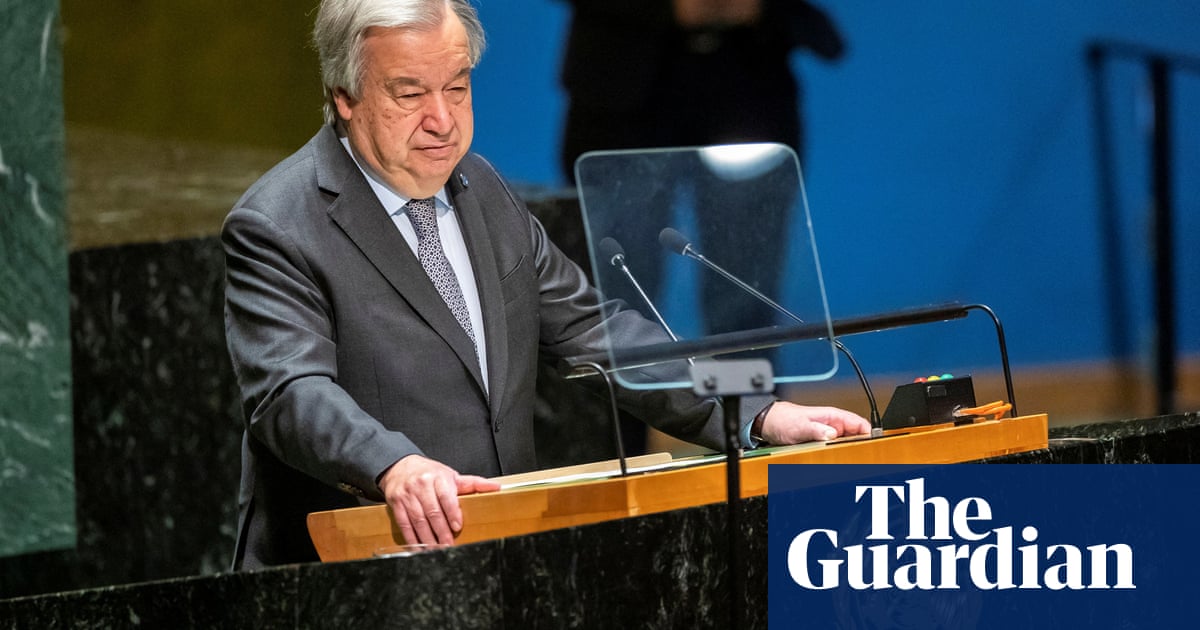The UN secretary general, António Guterres, has warned that the spread of artificial intelligence technology multiplies the threat of nuclear war, and that humanity is now “on a knife’s edge” as dangers to its existence coalesce.
Guterres’s warning is due to be shown on a recorded video to be played on Friday morning at the annual meeting of the US Arms Control Association (ACA) in Washington.
In the video, the secretary general makes his most impassioned plea to date for the nuclear weapons states to take their non-proliferation obligations seriously, and in particular, agree on a mutual pledge not to be the first to use nuclear weapons.
“The regime designed to prevent the use, testing and proliferation of nuclear weapons is weakening,” Guterres says in the recorded message, in a warning that comes with some 600 days to go before the expiry of the 2010 New Start accord between the US and Russia, the last remaining agreement limiting the strategic arsenals of the two nuclear superpowers.
Moscow has taken to making frequent threats of nuclear use, and China’s stockpile, while small compared with those of the US and Russia, is growing steadily.
More than 30 years since the end of the cold war, the US and Russia keep many of their intercontinental ballistic missiles on a hair-trigger alert, ready to launch at a few minutes’ warning. There are fears that in the drive to bolster each nation’s deterrent, launch procedures are being streamlined potentially with the help of AI.
“Humanity is on a knife’s edge; the risk of a nuclear weapon being used has reached heights not seen since the cold war,” Guterres says in his ACA address. “States are engaged in a qualitative arms race. Technologies like artificial intelligence are multiplying the danger.”
“All countries must agree that any decision on nuclear use is made by humans, not machines or algorithms,” Guterres insisted.
Two years ago, the US, UK and France issued a joint statement on the need to “maintain human control” of nuclear launches. Russia and China have yet to issue any comparable declaration.
According to estimates by the Federation of American Scientists (FAS), the number of nuclear weapons has declined dramatically since the cold war from a 1986 peak of about 70,300 weapons in 1986 to an estimated 12,100 this year. The total inventory continues to fall gradually as retired weapons are dismantled, but the total military stockpile of warheads available for use has begun to increase again, after the long post-cold war decline, the FAS warned.
after newsletter promotion
Guterres said it was the responsibility of nuclear weapons states to lead a return to disarmament. “They must resume dialogue and commit to preventing any use of a nuclear weapon,” he said. “I also urge the United States and the Russian Federation to get back to the negotiating table, fully implement the New Start treaty and agree on its successor.”
At last year’s ACA meeting, the US national security adviser, Jake Sullivan, offered to engage in talks “without preconditions” on a new agreement to replace New Start, but the Kremlin has rejected the offer.
Guterres also repeated his previous appeals for the nuclear powers to reaffirm a moratorium on nuclear testing, and to “agree that none will be the first to launch” a nuclear warhead.
Earlier this year, China suggested a “no first use” treaty. The US responded by saying it was ready to engage in a discussion on the subject. Mallory Stewart, an assistant secretary of state, told the ACA in April she “would love to ask” Chinese officials about the idea in the context of a broader conversation about strategic risks. But US officials say there has not so far been a “substantive response” to the US suggestion of a dialogue, and has not so far agreed to arrange a sequel to a bilateral arms control meeting held last November.

